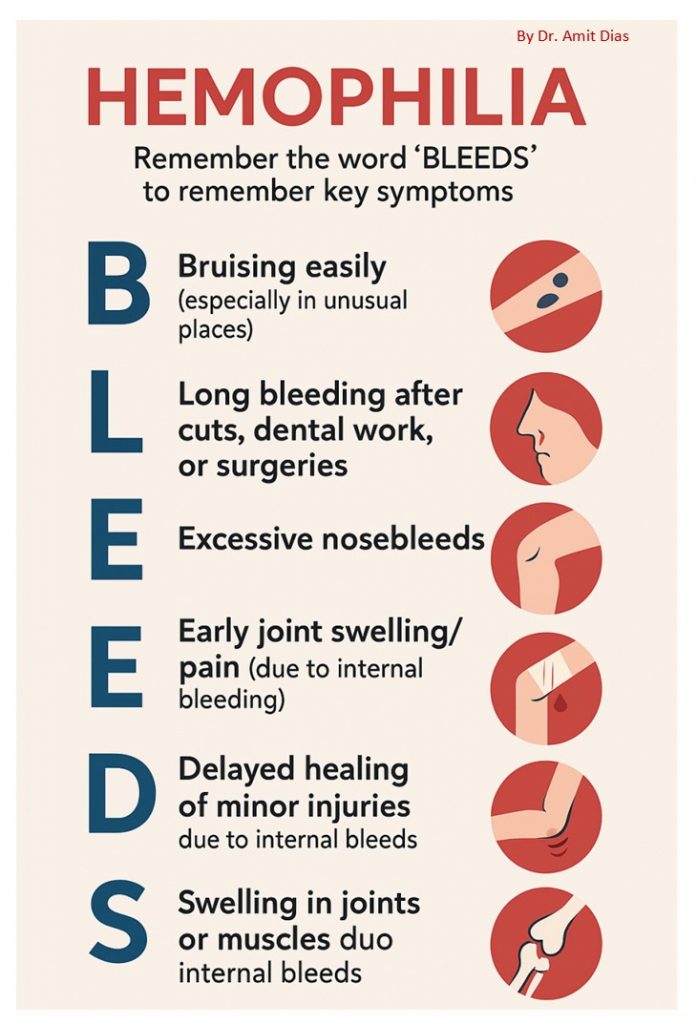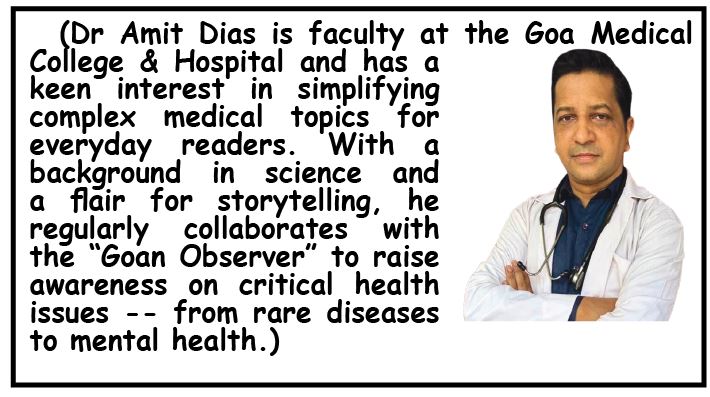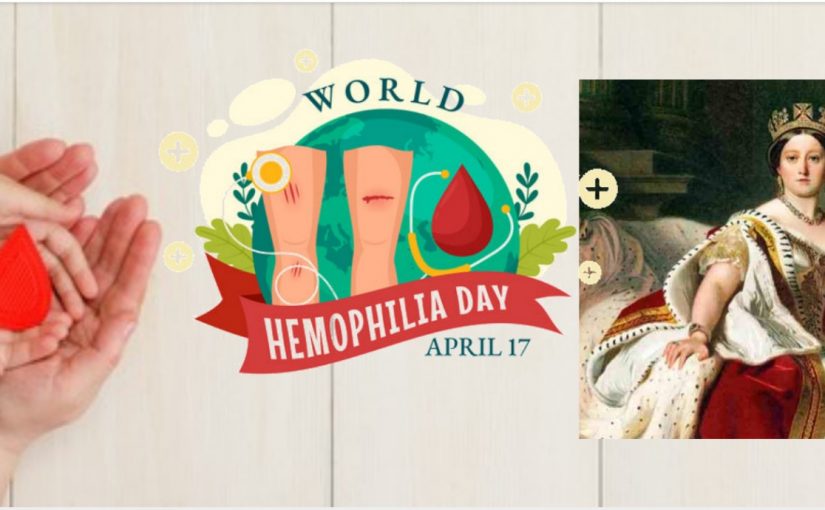Q&A interview with Dr Amit Dias on `World Hemophilia Day’
On World Hemophilia Day, April 17 we spoke to Dr Amit Dias, public health expert and passionate advocate for rare health problems, to shed light on hemophilia — a condition often misunderstood, sometimes overlooked, but very much manageable with the right care. According to Dr Dias, “Hemophilia doesn’t mean you’re fragile – it means you’re rare. And rare deserves recognition, not silence.”
From understanding why it’s called the “Royal Disease” to how Goa is caring for its children with hemophilia with Emicizumab, this article flows through science, awareness and hope.
Q: Doctor, to begin with, could you please explain in simple words — What is hemophilia? Do people get it in Goa?
Dr Amit Dias: Yes we do have people in Goa with hemophilia. Hemophilia is a rare, inherited bleeding disorder where the blood doesn’t clot properly. Normally, when we get injured, our body uses clotting factors — proteins in the blood — to stop bleeding. In people with hemophilia, one of these clotting factors is missing or not working properly. As a result, even minor injuries can lead to prolonged bleeding, and in severe cases, spontaneous internal bleeding can occur, especially into joints and muscles. Not many people know about this condition and therefore we need to use the opportunity of World Hemophilia day to raise awareness, improve diagnosis, and advocate for better treatment and support.
Q: What is special about April 17? Why is World Hemophilia Day observed on this day?
A: This day marks the birthday of Frank Schnabel, the founder of the World Federation of Hemophilia. He was a Canadian who lived with hemophilia-A and dedicated his life to raising awareness and improving care for those affected by the condition. It was his mission to improve the treatment and care for hundreds of thousands of people with hemophilia.
Q: What are clotting factors, and which ones are responsible for hemophilia?
A: Clotting factors are special proteins in our blood that work together to form blood clots and stop bleeding. Hemophilia occurs due to a deficiency of certain clotting factors:
Hemophilia A is caused by a deficiency of Factor VIII
Hemophilia B results from a deficiency of Factor IX.
Hemophilia C is less common and involves Factor XI.
Q: What are the different types of hemophilia?
A: As I mentioned:
Hemophilia A (Classic Hemophilia) – due to lack of Factor VIII – is the most common type.
Hemophilia B – due to lack of Factor IX. By the way, Hemophilia B is also called Christmas Disease, and it has got nothing to do with Christmas but named after Stephen Christmas, the first diagnosed patient.
Hemophilia C – due to lack of Factor XI – is usually milder and more common in certain populations like Ashkenazi Jews.
Q: Is hemophilia always present from birth, or can someone develop it later in life?
A: Most cases are inherited and present from birth, but there are rare instances of acquired hemophilia, where the body develops antibodies against clotting factors, typically in adulthood, often linked to autoimmune conditions, pregnancy, or certain cancers.
Q: What is the burden of hemophilia globally and in India?
A: Globally, hemophilia affects about 1 in 10,000 births. India has over 20,000 registered cases, but it is estimated that many more go undiagnosed due to lack of awareness and diagnostic facilities. The burden includes not only the health challenges but also financial, emotional, and social difficulties.
Q: How dangerous is hemophilia? What are the complications?
A: If not treated properly, hemophilia can be life-threatening. Complications include:
Bleeding into joints, causing pain, swelling, and long-term joint damage.
Bleeding into vital organs, like the brain, can be fatal.
Anemia from chronic blood loss.
Inhibitor development, where the body rejects replacement therapy.
With proper treatment, however, people with hemophilia can live long and productive lives.
Q: How can one recognize hemophilia early? What should parents look out for?
A: Parents should remember the word BLEEDS
B – Bruising easily (especially in unusual places)
L – Long bleeding after cuts, dental work, or surgeries
E – Excessive nosebleeds
E – Early joint swelling/pain (due to internal bleeding)
D – Delayed healing of minor injuries
S – Swelling in joints or muscles due to internal bleeds
This can help parents and caregivers recognize signs early and seek timely medical help.
Q: You mentioned hemophilia is genetic. How is it inherited?
A: Hemophilia A and B are X-linked recessive disorders. Since males have only one X chromosome, if it carries the defective gene, they will have the disease. Females, with two X chromosomes, are usually carriers and rarely show symptoms but can pass the gene to their sons. If a woman is a carrier, there’s a 50% chance her son will have hemophilia, and a 50% chance her daughter will be a carrier.

Q: I know hemophilia as the “royal disease.” Why does it have this tag?
A: That’s right. It’s called the royal disease because it famously affected the royal families of Europe, particularly the descendants of Queen Victoria. who was a carrier. Her son Leopold had hemophilia, and the condition was passed down through generations, affecting royal families in Spain, Germany and Russia. It’s very interesting as the royals would marry within the family and the genetic disorders would express themselves.
Q: Do women get hemophilia too?
A: Yes, although rare, women can have hemophilia if both X chromosomes carry the faulty gene, or in cases of X-chromosome inactivation. More commonly, female carriers may have lower-than-normal levels of clotting factors and experience bleeding symptoms like:
Heavy menstrual bleeding.
Bleeding after childbirth or surgery.
Easy bruising.
The theme this year “Access to all: Women and Girls Bleed too” is about recognizing and addressing bleeding disorders in women, which are often underdiagnosed.
Q: Can hemophilia be treated? What is the modern approach to its management?
A: Absolutely. Modern treatment has advanced significantly. Management includes:
Replacement therapy: Infusing missing clotting factors into the bloodstream.
Prophylactic treatment: Regular infusions to prevent bleeds, especially in children. This is now the preferred method, but can be very expensive.
Non-factor therapies: Like Emicizumab for Hemophilia A, which mimics Factor VIII, have now become the drug of choice and is given prophylactic.
Gene therapy: Still being studied but offers hope for long-term correction.
With the right care, children with hemophilia can lead nearly normal lives.
Q: Are children with hemophilia advised to avoid any activities or medicines?
A: Yes, children should avoid:
Contact sports like football, wrestling, etc, should be avoided to prevent injury.
Medications like aspirin or NSAIDs, which affect platelets and worsen bleeding.
However, safe exercises like swimming and cycling are encouraged to strengthen muscles and joints. Vaccinations should be given with caution, using the smallest needle and applying pressure afterward.
Q: You mentioned we have cases of hemophilia in Goa, could you elaborate?
A: Yes, Goa has around 70 to 80 registered cases of hemophilia. The Hemophilia Society of Goa is active in supporting affected individuals and their families by providing factor replacement therapy, education, and counseling. We had an opportunity to hear from some of them and their families at a function held in GMC recently. The Goa Model of Health Care under our Health Minister is an absolute blessing for those with this rare disease.
Q: This was a very informative conversation. What is your message on World Hemophilia Day?
A: My message is clear: Hemophilia doesn’t mean you’re fragile—it means you’re rare. And rare deserves recognition, not silence. Hemophilia is not the end — it’s a condition that can be managed. Let’s work to ensure early diagnosis, access to treatment, and support for patients and families. This year, let us also remember the silent sufferers—women with bleeding disorders—and ensure they too receive the care they deserve. Together, we can build a world where no one bleeds unnecessarily.
Together we can ensure Access to All

